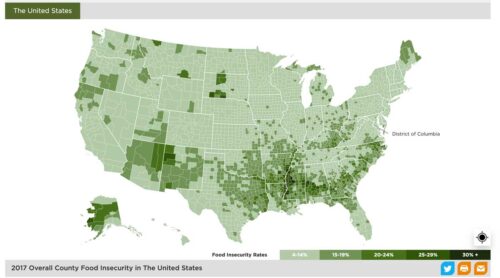Food Insecurity
Here is a basic page layout with no sidebarAccording to the United Nations Food and Agriculture Organization, over 820 million people do not have enough to eat. In 2018, one out of every 9 Americans in the U.S. were food insecure. The pandemic has increased those numbers. In a country like the United States where more than enough food is produced, there is no reason or excuse for anyone to go hungry.

Food insecurity is a complex problem and is often related to more than poverty, such as health problems, low wages, lack of affordable housing and social isolation. According to research published in the Canadian Medical Association Journal, people with food insecurity are 10% to 37% more likely to die prematurely from any cause other than cancer compared to food-secure individuals.
SNAP, the U.S.’s food stamp program, helps many food insecure families, but the Trump Administration is making it much harder for residents to receive benefits so alternative ways of getting healthy food to the food insecure is needed.
Food Insecurity versus Hunger
Food insecurity and hunger are separate issues. Food insecurity is socio-economic, meaning it’s both financial and cultural, and it focuses on access to the right kind of food. Hunger is a physical sensation that comes from not eating. In addition, food security is measured by household, while hunger is based on the individual. This means that parents in a food insecure home might have enough to feed their children but who go hungry because there is not enough food for them also.

There are several ways to end food insecurity in households around the world, the first and easiest being to provide healthy food to food insecure families for free like Plant Eat Share is promoting!
Other ways include:
- Community gardens. According to a study by the University of California and Santa Clara University, people who maintained a garden – whether at home or a community garden – were more likely to eat vegetables. Families get not just more food, but healthier food.
- Food apps. With most people at all income levels now owning a smartphone, apps such as Australia’s Y Waste are finding ways to connect individuals to food that would otherwise be thrown out in grocery stores. Users are notified when a store has excess food; they simply claim they food they want and pick it up at the counter just as any customer would, eliminating any stigma attached to receiving a food donation. Apps such as Food for All are offering discounted restaurant food that would otherwise go to waste.
- Free food sharing. Food pantries and food banks are located all throughout the country and definitely help ease food insecurity by providing food to those in need. There is also a movement to help pantries provide fresh fruits and vegetables. You can find your local U.S. food bank by using Feeding America’s map.

Lorem Ipsum Dolor
Nunc et vestibulum velit. Suspendisse euismod eros vel urna bibendum gravida. Phasellus et metus nec dui ornare molestie. In consequat urna sed tincidunt euismod. Praesent non pharetra arcu, at tincidunt sapien. Nullam lobortis ultricies bibendum. Duis elit leo, porta vel nisl in, ullamcorper scelerisque velit. Fusce volutpat purus dolor, vel pulvinar dui porttitor sed. Phasellus ac odio eu quam varius elementum sit amet euismod justo.
Lorem Ipsum Dolor
Nunc et vestibulum velit. Suspendisse euismod eros vel urna bibendum gravida. Phasellus et metus nec dui ornare molestie. In consequat urna sed tincidunt euismod. Praesent non pharetra arcu, at tincidunt sapien. Nullam lobortis ultricies bibendum. Duis elit leo, porta vel nisl in, ullamcorper scelerisque velit. Fusce volutpat purus dolor, vel pulvinar dui porttitor sed. Phasellus ac odio eu quam varius elementum sit amet euismod justo.
Lorem Ipsum Dolor
Nunc et vestibulum velit. Suspendisse euismod eros vel urna bibendum gravida. Phasellus et metus nec dui ornare molestie. In consequat urna sed tincidunt euismod. Praesent non pharetra arcu, at tincidunt sapien. Nullam lobortis ultricies bibendum. Duis elit leo, porta vel nisl in, ullamcorper scelerisque velit. Fusce volutpat purus dolor, vel pulvinar dui porttitor sed. Phasellus ac odio eu quam varius elementum sit amet euismod justo.
Lorem Ipsum Dolor
Nunc et vestibulum velit. Suspendisse euismod eros vel urna bibendum gravida. Phasellus et metus nec dui ornare molestie. In consequat urna sed tincidunt euismod. Praesent non pharetra arcu, at tincidunt sapien. Nullam lobortis ultricies bibendum. Duis elit leo, porta vel nisl in, ullamcorper scelerisque velit. Fusce volutpat purus dolor, vel pulvinar dui porttitor sed. Phasellus ac odio eu quam varius elementum sit amet euismod justo.
Lorem Ipsum Dolor
Nunc et vestibulum velit. Suspendisse euismod eros vel urna bibendum gravida. Phasellus et metus nec dui ornare molestie. In consequat urna sed tincidunt euismod. Praesent non pharetra arcu, at tincidunt sapien. Nullam lobortis ultricies bibendum. Duis elit leo, porta vel nisl in, ullamcorper scelerisque velit. Fusce volutpat purus dolor, vel pulvinar dui porttitor sed. Phasellus ac odio eu quam varius elementum sit amet euismod justo.
